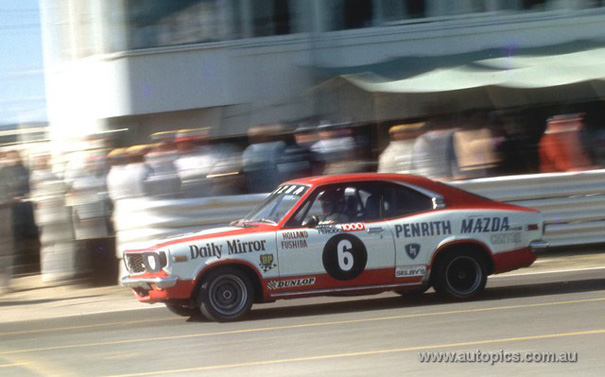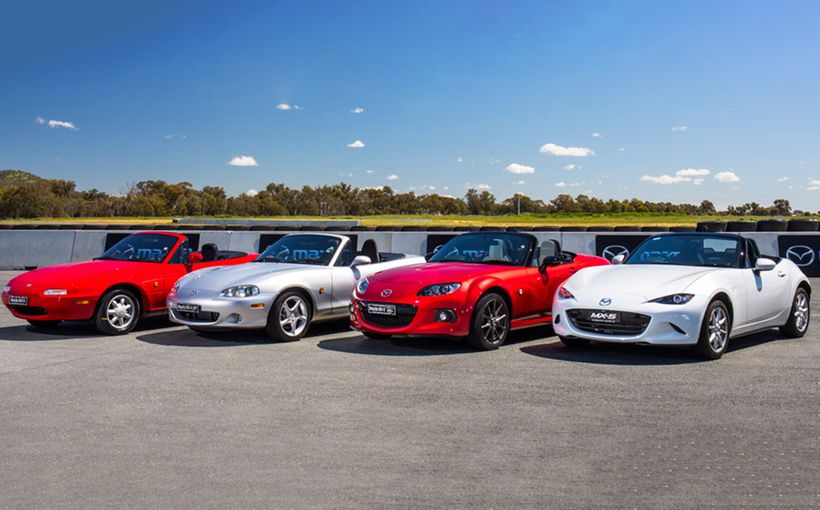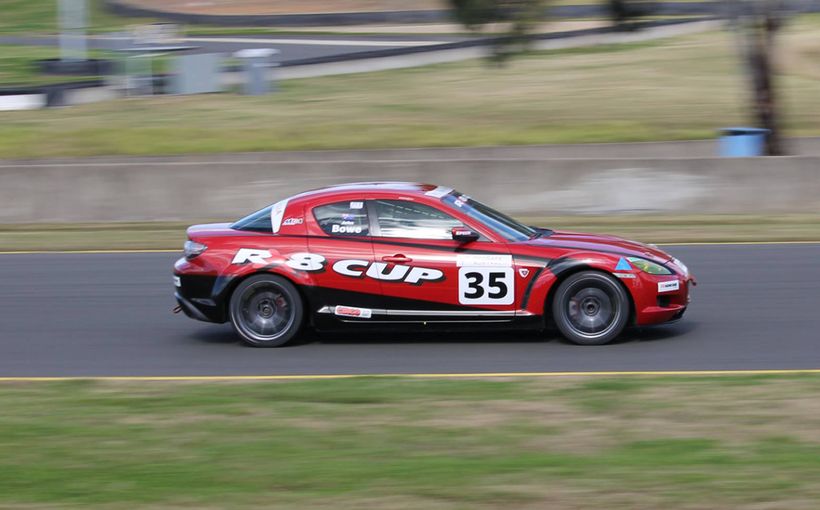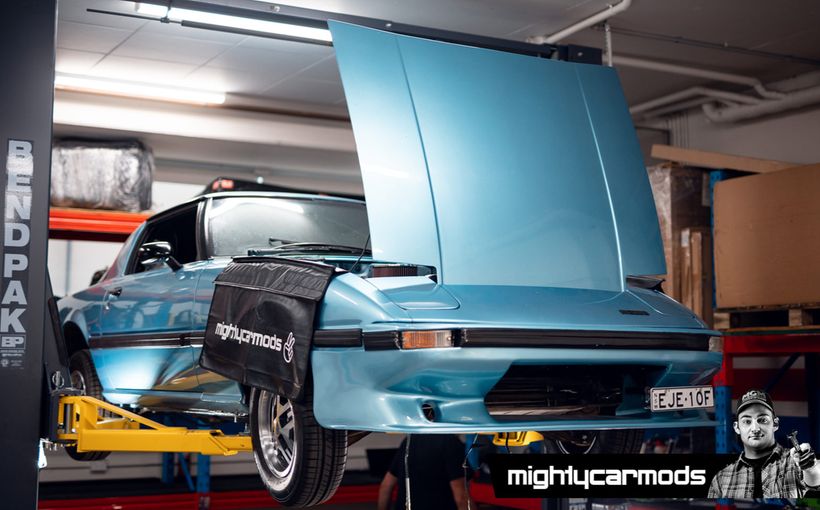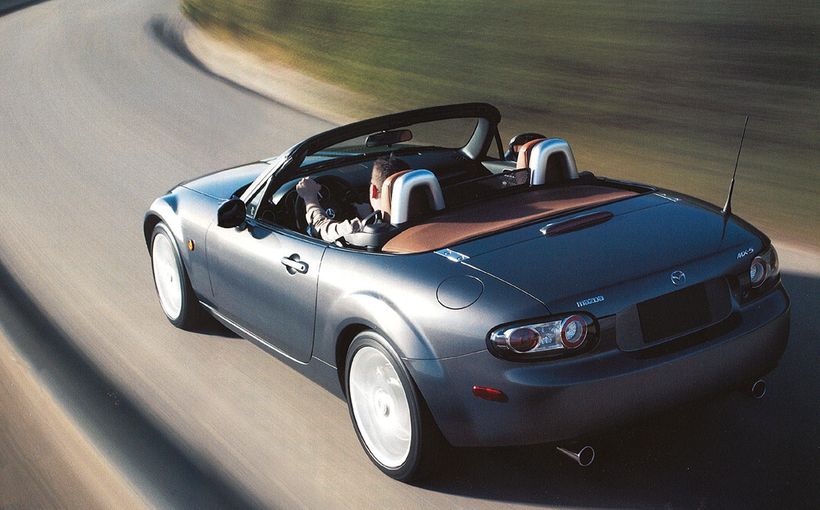Mazda RX-3: The giant-killing rotary that put the R in Respect for ’Rice Burners’

Prior to the appearance of a trio of Mazda R100 coupes in the 1969 Hardie-Ferodo 500 at Bathurst, no one had heard the bizarre exhaust note of a rotary-powered Mazda on Mount Panorama.
With the standard road-legal exhaust systems required at the time, the Wankel rotary-powered coupes emitted a muffled noise similar to that made when tearing a large sheet of paper.
The change from Series Production to Production Touring (Group C) rules in 1973 allowed for various modifications to be made. This included exhaust systems, which were free after the manifold. In other words, you could run big open pipes with no mufflers.
While this move increased the power outputs (and decibels) of the category’s booming V8s, high-revving sixes and hot fours, the audible change was most noticeable in the then-latest Mazda RX-3 rotaries which produced a frenzied, high-pitched buzz that sounded like a swarm of angry bees.
The shrill, ear-splitting sound from these open-piped Japanese cars had many fans reaching for their ear-plugs. It also wasn’t long before they also started attracting nicknames among Aussie race fans like “egg-beaters” “buzz-bombs” and “rotisseries”.
The tag which soon struck a universal chord though was “rice burner” which suggested that the Japanese could do anything with a bowl of rice - even create a special rotary fuel called Riceoleum!
Despite this good natured ribbing, Aussie race fans came to begrudgingly respect the RX-3 for no other reason than its ability to get the job done on the race track in convincing style.
In the mid-1970s the formidable speed and rock-solid reliability of the RX-3 coupe was at its peak, resulting in a string of giant-killing performances. It not only regularly won its class but often finished so high in the outright placings that it embarrassed many V8 Falcons and Toranas of the era.

1973: Big on revs, small on torque
The R100 and its larger more powerful 1971 replacement, the Capella/RX-2, pioneered the use of rotary power at Bathurst under the showroom-stock Series Production rules at the time, which included an impressive class victory for Gary Cooke’s RX-2 in 1971.
The more liberal Group C rules came into force in 1973, after Mazda’s new RX-3 sedan and coupe models had gone on sale the previous year.
Powered initially by the 10A rotary, which in standard trim was rated at 78 kW (105 bhp) at 7000 rpm with 135Nm (100 ft/lbs) of torque at 4000 rpm, the RX-3 series continued the conventional front engine/rear drive layout of the Capella, riding on a 2286mm wheelbase with MacPherson strut front and leaf-sprung live axle rear suspension.
It was thrust into battle in the 1973 Manufacturers Championship, which comprised five long distance races including the Bathurst 1000.
Under Group C, Bathurst classes based on engine capacities put the new RX-3 into Class B (1301-2000cc) where it competed against the Alfa Romeo 2000 GTV, Escort Twin-Cam and Datsun 180B. How so, you might ask, when the RX-3’s pair of 491cc rotors added up to a combined cubic capacity of only 982cc?

It was simply because motor sport’s world governing body, the FIA, was so impressed by the efficiency of Dr Wankel’s design it was considered to be the equal of a conventional engine of twice its capacity.
Therefore the new RX-3’s 982cc 10A rotary was listed as 1964cc (982cc x 2) and competed in the 2.0 litre class. Even so, with a kerb weight of less than 900 kgs Mazda’s new model was lighter than its more powerful RX-2 predecessor and was considered to have a good chance of success.
In the skilled hands of former Mazda 1300 racers Mel Mollison and Geoff Perry, their new semi-works RX-3s backed by enthusiastic Mazda dealers performed solidly and reliably in the ’73 ManChamp.
However, they could not match the raw speed of Alfa’s 2000 GTV which between Ray Harrison and Christine Cole won all five rounds in a resounding clean-sweep for the Italian marque.

1974 Giant Killers: Tony Farrell, Len Bainbridge and the Mazda RX-3
The RX-3 was destined to reach much greater heights with the arrival in early 1974 of the Series II model, powered by the latest version of the larger and more powerful 12A with 97kW (130 bhp) and 156 Nm (115 ft/lbs) of torque. The 25 bhp power boost was off-set by a 44 kgs weight increase.
The Series II’s pair of larger 573cc rotors had a combined cubic capacity of 1146cc which when subjected to the FIA’s parity formula resulted in a nominal capacity of 2292cc.
This larger 2.3 litre engine bumped the RX-3 up into the 2001-3000cc division (Class C) or what was generally referred to as the 3.0 litre class.
Here the RX-3’s main competition in the ’74 ManChamps would come from Datsun 240K, Torana GTR and 3.0 litre BMW rivals. On paper, though, the Mazda’s athletic power-to-weight ratio and reliability would prove formidable in the talented hands of Tony Farrell.
The Victorian was not only a fine driver but also regarded as one of the country’s best chassis tuners, with hands-on experience in the design and construction of one Australia’s fastest Clubman-type sports racing cars.
Farrell, in partnership with Daryl Davies, was also at the time hard at work on the ‘Ilinga AF2’ project; a courageous but ill-fated attempt to build a low volume, luxurious four-seat grand tourer in Australia that could rival exotic imports.
Melbourne Mazda dealer, Len Bainbridge, who had backed various Mazda squads in previous seasons, had come on board as a financial backer of the exciting Ilinga initiative.
Well aware of Farrell’s driving and tuning talents, Bainbridge also backed him in a new 12A RX-3 coupe for a serious crack at the 1974 ManChamps, which like the previous year was comprised of five long distance races including the Bathurst 1000.

The RX-3 remained remarkably close to standard road-going trim under the Group C rules, with only minor modifications allowed in key areas to improve its performance and durability.
When this car was tested by Sports Car World magazine in 1975 (after it had been sold to Sydney driver Don Holland) its standard port twin-rotor 12A engine was untouched inside as demanded by the rules governing rotary engines.
Externally, though, it enjoyed the same freedoms of induction and exhaust as conventional piston-engined cars.
A big 58mm DCOE Weber twin-choke carburettor on a special adaptor replaced the standard Stromberg unit. And a set of tubular headers fed into the ear-busting open exhaust pipe that exited under the rear bumper, legally bypassing Mazda’s Rotary Engine Anti-Pollution System (REAPS) fitted for road use.
Holland confirmed that this engine’s power output at this time was just under 180 bhp with a screaming 8000 rpm redline. However, like Farrell he did lament the rotary engine’s lack of torque compared to the conventional piston-engined cars of his competitors, particularly at race starts with a full tank of fuel on board.
Given this 180 bhp figure was similar to those claimed by some of the top 2.0 litres cars of the period, like the works Alfa Romeo 2000 GTVs and Escort RS2000s, the FIA’s 2.3 litre engine equivalency rating for the RX-3 was close to the mark.
Front suspension was beefed up with shorter and stiffer coil springs, fatter anti-roll bar and Koni adjustable shocks. The leaf-sprung live axle rear-end featured stiffer spring packs, adjustable shocks plus a Panhard rod and anti-tramps bars to better control rear axle behaviour.

Inside the fully trimmed cabin, the only changes from the road car were a sturdy bolt-in roll cage, driver’s racing harness and extra dashboard gauges to keep a more accurate eye on the engine’s water temperature and oil pressure.
The 12A rotary was a thirsty worker, so the boot was filled with a huge 113-litre (25-gallon) long-range fuel tank made from lightweight aluminium, with an internal anti surge bladder tank for added safety in the event of a major accident.
The racing RX-3 sat fat on wider 13-inch diameter three-piece Simmons wheels that filled the standard wheel wells with plenty of Dunlop race rubber, resulting in a footprint nearly 250mm wide on each of the rear boots.
The result of the Farrell/Bainbridge partnership with this car in 1974 was astounding, with Farrell taking a clean-sweep of five 3.0 litre class wins from five rounds, securing the ManChamp title for Mazda in emphatic style.
It was the giant-killing character of Farrell’s RX-3 victories that earned such solid respect from rival competitors and fans, as the Bainbridge-backed entry often finished higher in the outright results than more powerful Ford and Holden V8 opposition.

It was an utterly dominant performance by Australia’s fastest 3.0 litre touring car at the time, but the sweet taste of the winner’s champagne soon soured when CAMS scrutineers excluded Farrell and his RX-3 from the results of the final round due to a dispute over the car’s slightly modified rear axles.
The car was fitted with what was described at the time as a factory-supplied ‘Mazda Sport Kit’ limited slip diff option which had resulted in the team machining 1.0 mm off the inner ends of each axle shaft for proper clearance.
Farrell’s team immediately lodged a protest with CAMS against the exclusion, claiming that the machining requirement was spelled out clearly in the instructions supplied with the unit. Thus began a drawn-out legal dispute to determine if the axle shortening was a specific factory requirement, or just a recommendation.
Finally, after six months of legal wrangling, Farrell’s protest was upheld and Mazda was allowed to officially claim the 3.0 litre Manufacturers Championship title it richly deserved.

1975-79: Mazda RX3 vs Ford Capri V6
Nothing could touch the RX-3 for 3.0 litre class honours in 1974 but Mazda’s rotary-powered rocket was to meet its match the following year when Bathurst winner Barry Seton fronted with a sleek Mark I Ford Capri GT 3000 powered by Ford’s torquey 2994cc ‘Essex’ V6.
The catalyst for the Capri’s sudden rise to prominence as a 3.0 litre class contender came from two major developments in the sport.
One was the change from Series Production to Production Touring (Group C) rules in 1973. Prior to this, when Bathurst classes were determined by retail price, the Capri was unfairly grouped with more powerful outright contenders.
However, Group C’s multi-class structure based purely on engine capacity made the Capri a potential 3.0 litre class winner, given its ideal engine capacity combined with a relatively low kerb weight (1080 kgs) that resulted in an excellent power-to-weight ratio.
The other breakthrough was when the Australian Racing Drivers Club announced a 3.0 litre engine limit for its annual Sun-7/Rothmans touring car series held at Sydney’s Amaroo Park.
The new format proved popular, attracting quality fields of different makes and models including Mazda (RX-3), Ford (Capri V6 and Escort RS2000), Alfa Romeo (2000 GTV), Toyota (Celica) and BMW (2002).

By this stage Farrell’s unbeaten RX-3 coupe had been sold to Don Holland, who had recently taken on a new Mazda dealership at Penrith in Sydney’s west. The former blue Bainbridge Mazda RX-3 was repainted in a new red and white colour scheme carrying Holland’s Penrith Mazda Centre signage.
Seton, who didn’t hide his dislike of foreign brands, claimed a properly prepared Capri V6 could win the series in defiance of many critics who claimed the Ford coupe could never topple the rotary rockets.
The RX-3 was about 150 kgs lighter than the V6-powered Capri but substantially smaller in engine capacity. And it could not match the prodigious low-down torque of the Capri engine, which gave the Ford a distinct advantage getting off the start line in such short sprint races.
Despite the RX-3s of Don Holland and Lakis Manticas finishing 1-2 in the opening round, the Capri critics were soon eating their words when Seton soon gained the upper hand, winning the remaining three rounds which concluded with a comfortable win in the 50-lap final.
Holland was the strongest of the RX-3 contenders, but his close-ratio four-speed gearbox (which was ideal for Bathurst) cost him dearly at the Amaroo race starts due to its tall first gear and the rotary’s lack of torque compared to the Ford V6.
The RX-3’s performances in the 1975 ATCC and ManChamps though provided more justification for the Japanese car’s giant-killing reputation.
Holland and Japanese co-driver Hiroshi Fushida starred at the Bathurst 1000 after Seton’s Capri struck rear axle trouble, winning Class C and finishing a stunning fifth outright - beaten only by a quartet of Torana V8s!
Holland claimed his top speed down Conrod Straight that year was 156 mph (250 km/h) which showed the tremendous top end power and low-drag aerodynamics of the rotary-engined coupe.
The Sydney driver chased the big cars home again at the next ManChamp round in Surfers Paradise, with another class win and sixth outright in the 300 km endurance race.

Prominent Torana L34 racer Allan Grice (Craven Mild Racing) was so impressed by the speed and reliability of the rotary Mazdas that he decided to join the Amaroo Park 3.0 litre series battle in 1976, driving the ex-Lakis Manticas RX-3 initially with backing from Mazda House.
It was a successful initiative for Grice, with two wins and two seconds from the four rounds to wrap up what had been a very close and competitive series. The Capris and RX-3s were now very evenly matched on the tight and twisty Sydney track.
Holland continued to be Mazda’s main striker in the 1976 ATCC which for the first time was combined with the ManChamps to create an arduous 11-round contest, with a complex points system that required a skilled accountant to work out.
The Capri V6 really started to flex its muscles in the ATCC, with Seton taking so many 3.0 litre class wins that he finished third overall in the series, beaten only by Moffat and Bond in their respective Falcon and Torana V8s. Holland finished second in class to Seton after scoring one class win.
Seton also left the Mazdas in his mirrors at Bathurst, with Holland and co-driver Lynn Brown finishing second in class a lap behind the flying V6 Ford. Even so, the top Capri and RX-3 finished inside the Top 10 and well ahead of numerous V8s.
Grice scored another highlight for Mazda by winning his class at the 500 km ManChamp final at Philip Island, with his RX-3 now presented in Gricey’s familiar gold and white Craven Mild livery.

In 1977 Seton again won the Amaroo 3.0 litre series and took class honours at Bathurst, in what was a forgettable year for the Mazdas on the Mountain. This was highlighted by Japanese driver Yoshimi Katayama, who destroyed Grice’s Craven Mild RX-3 in a fearful high-speed barrel roll at Murray’s Corner. Fortunately, Katayama walked away from the wreck uninjured.
The debut of the new Capri II Hatchback model in 1978 raised the bar even higher for the Mazda runners. By 1979, though, the RX-3 teams were unleashing more power from the venerable 12A engine after the bigger breathing bridge-port version had been approved.
The combined driving talent and masterful rotary tuning expertise of Barry Jones was showcased at the ’79 Bathurst 1000 when his bridge-port RX-3 blitzed the 3.0 litre class in practice, lapping more than three seconds faster than anyone on a wet track to nail pole position.
Jones and co-driver Terry Finnigan proved more than a match for the Capris in the race too and were leading the 3.0 litre class handsomely until a cruel engine failure (reportedly caused by a stone getting ingested) ended their inspired charge after 106 laps.
Even so, Mazda still finished on a Capri-beating high thanks to the efforts of privateers Barry Lee and John Gates in their RX-3 who prevailed over the crippled Steve Masterton/Phil Lucas Capri to win the 3.0 litre class by a massive six laps.

1980-82: A stay of execution
With the all-new Mazda RX-7 model making its Bathurst debut in 1979, it was clear the ageing RX-3 was nearing retirement after seven straight seasons and with local showroom sales of the model having ceased several years before.
However, with the sport’s governing body CAMS overseeing the difficult introduction of a new set of Group C touring car rules for 1980, the RX-3 was granted an extension to continue competing in the 3.0 litre class.
This would suffice until the rule makers had decided if its RX-7 replacement was going to remain a 3.0 litre class competitor with the same bridge-port 12A engine, or become an outright contender with the more powerful peripheral-port 12A (approval for the peripheral port RX-7 was granted in 1981).
The most noticeable change in the RX-3s under the new rules were large front spoilers and Torana L34-style fiberglass wheel arch extensions, reflecting greater freedoms in rim offsets and tyre sizes.
Numerous RX-3s continued to compete in Group C touring car racing with several impressive results against the Capris from 1980 to 1982, although they were not seen again at Bathurst after the ’79 race due to a new rule that allowed only models less than four years old to compete.
Even so, after almost a decade of competition at the highest level, the RX-3 had done its job for Mazda by delivering a trophy cabinet bursting with giant-killing class victories, which proved beyond doubt the enduring speed and enviable reliability of the corporation’s rotary engine.
Protect your Mazda. Call Shannons Insurance on 13 46 46 to get a quote today.

